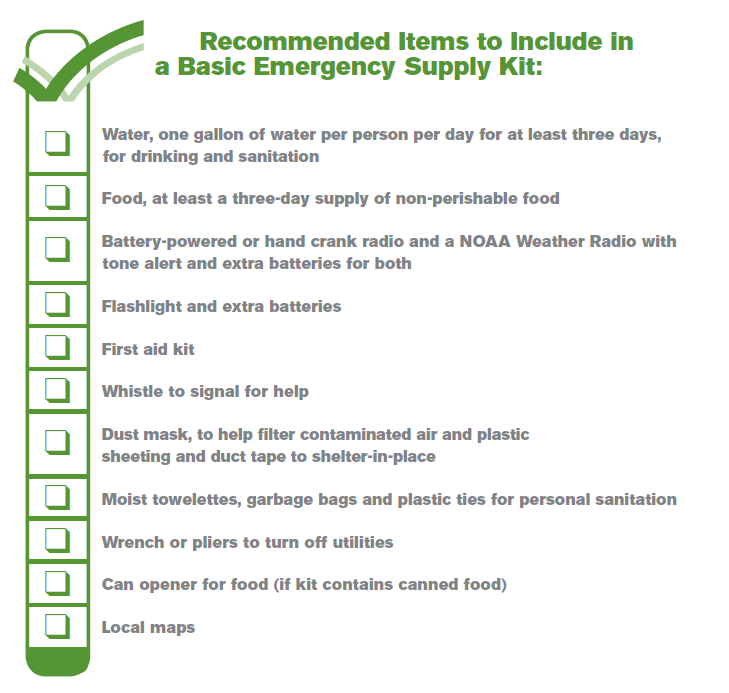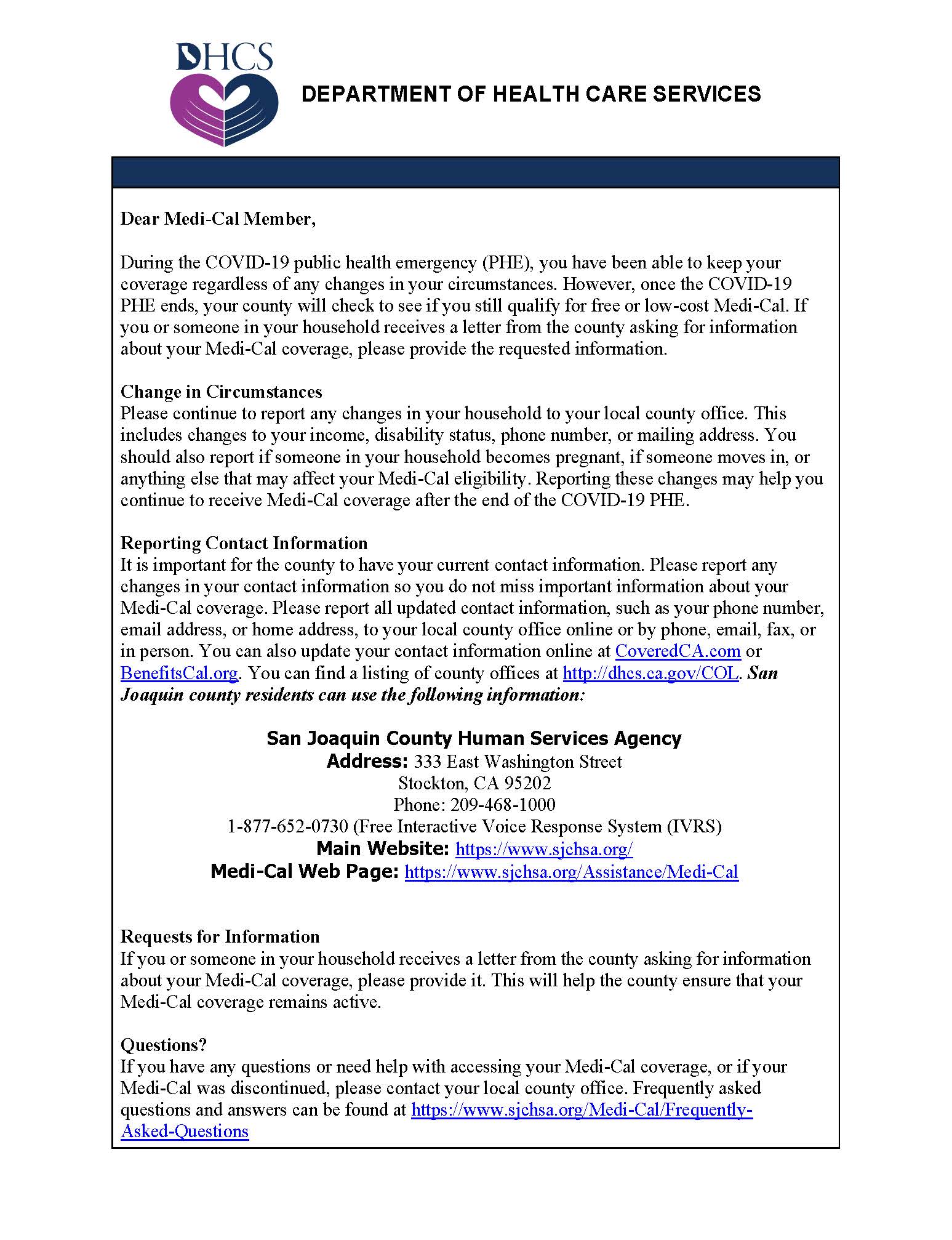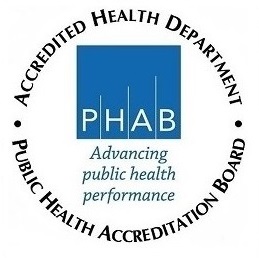Downloadable Documents:
Personal and Family Preparedness
If a disaster strikes your community, you might not have access to food, water, or electricity for some time. Here are some steps you can take now to help prepare yourself and your family to stay safer and healthier during and after a disaster.
Build a Kit
A disaster supplies kit is a collection of basic items your household may need in the event of an emergency. Assemble your kit well in advance of an emergency. You may have to evacuate at a moment's notice and take essentials with you. You may need to survive on your own after an emergency. This means having your own food, water and other supplies in sufficient quantity to last for at least 72 hours. This is called "Shelter-in-Place". Local officials and relief workers will be on the scene after a disaster but they cannot reach everyone immediately. You could get help in hours or it might take days. Additionally, basic services such as electricity, gas, water, sewage treatment and telephones may be cut off for days or even a week, or longer. Your supplies kit should contain items to help you manage during these outages.

- Basic Emergency/Disaster Supplies Kit includes:
- Water, one gallon of water per person per day for at least three days, for drinking and sanitation
- Food, at least a three-day supply of non-perishable food
- Battery-powered or hand crank radio and a NOAA Weather Radio with tone alert and extra batteries for both
- Flashlight and extra batteries
- First aid kit
Make a Plan
Your family may not be together when a disaster strikes so it is important to plan in advance: how you will get to a safe place; how you will contact one another; how you will get back together; and what you will do in different situations. Read more about Make a Plan | Ready.gov during an emergency. Ready.gov has made it simple for you to make a family emergency plan. Download the Make a Plan Form | Ready.gov (PDF) and fill out the sections before printing it or emailing it to your family and friends.
Evacuation
Prepare now in the event of an evacuation. Evacuations are more common than many people realize. Fires and floods cause evacuations most frequently. In addition, transportation and industrial accidents can release harmful substances, forcing many people to leave their homes.Children
Children have special needs that require planning before, action during and assistance after an emergency. Talk with your children and grandchildren about being ready for any type of disaster. Use the ready.gov/kids materials to help them understand basic disaster preparedness which will assist them in being more equipped to survive. Children can and should be encouraged to play an active role in their personal safety. Request and review school emergency plans. Students requiring additional assistance should have an emergency plan at school, home and during transportation. Extra medication may need to be stored with the school nurse should your child's school enter into a “lock-down”. Know how you will be contacted and reunited with your child if the school is evacuated or students must Shelter-in-Place.Older Adults
There are common sense measures older Americans can take to start preparing for emergencies before they happen. Create a network of neighbors, relatives, friends and co-workers to aid you in an emergency. Discuss your needs and make sure everyone knows how to operate necessary equipment. If appropriate, discuss your needs with your employer, neighbors or community Senior Center. Keep specialized items ready, including extra wheelchair batteries, oxygen, catheters, medication, food for service animals and any other items you might need. Make a list of the type and model numbers of the medical devices you require. Be sure to make provisions for medications that require refrigeration. Make arrangements for any assistance to get to a shelter.Individuals with Disabilities or Functional and Access Needs
If you have a disability or an access and functional need, you may need to take additional steps to prepare for emergencies:- Stock a basic disaster supply kit.
- Inventory what you use every day to live independently. Identify the essential things that you will need to be able to survive for 3 to 5 days or longer, if people cannot get to you.
- Stock these custom essentials in your kit. For example, your kit may contain items such as durable medical equipment, assistive technology, food for special diets, prescription medicines, diabetic supplies, hearing aids and batteries, a TTY, manual wheelchair, and supplies for a service animal.
Pets
 If you are like millions of animal owners nationwide, your pet is an important member of your household. Unfortunately, animals are also affected by disaster. The likelihood that you and your animals will survive an emergency such as a fire or flood, tornado or terrorist attack depends largely on emergency planning done early on. Not all shelters are equipped to receive animals. You are responsible for their health and safety.
If you are like millions of animal owners nationwide, your pet is an important member of your household. Unfortunately, animals are also affected by disaster. The likelihood that you and your animals will survive an emergency such as a fire or flood, tornado or terrorist attack depends largely on emergency planning done early on. Not all shelters are equipped to receive animals. You are responsible for their health and safety.
Additional Resources

- San Joaquin County Office of Emergency Services
- CDPH Emergency Preparedness Office ‐ Be Prepared California
- FEMA (Federal Emergency Management Agency)
- Free Publications
- NOW IT'S TIME TO PRACTICE
- Pet Disaster Checklist Fillable Form
- Help Others learn how to get ready for emergencies
- How to prepare and respond during and after an Active Shooter Incident
- more...


